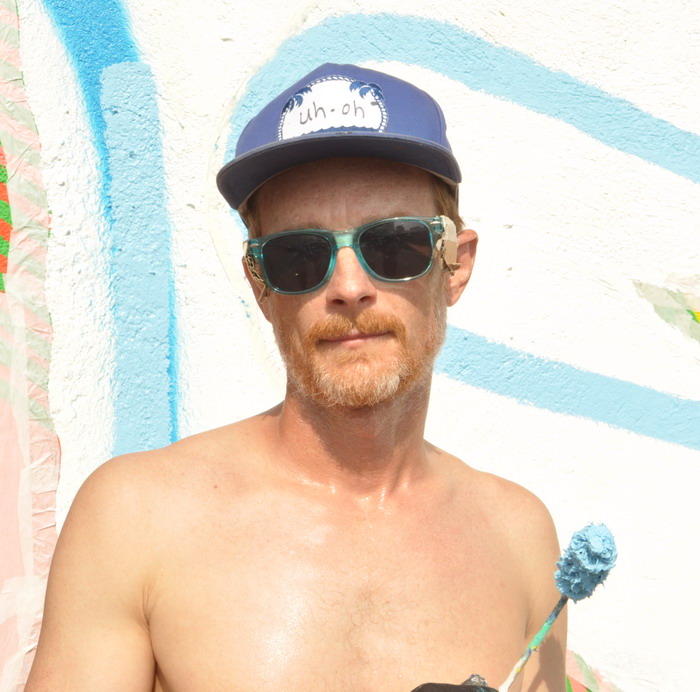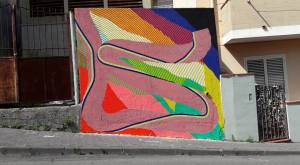
BIOGRAFIA: MOMO è un’artista che opera in spazi pubblici con attrezzi di prima mano. I suoi interessi risiedono in un’ampia gamma di tecniche murarie per abbozzare, disegnare e dipingere murali. Nato a San Francisco nel 1974, MOMO ha viaggiato moltissimo, ha vissuto a New York per sei anni e attualmente ha uno studio a New Orleans.
Nel 2008 Rojo ha pubblicato le prima monografia “3AM – 6AM”; nel 2012 Studio Cromie ha pubblicato la seconda, “In 74 Pieces”. Nel 2013 la Galleria May ha ospitato la sue prima installazione “Butt Joints” a New Orleans; Studio Cromie ha prodotto un tour caraibico ed una mostra nel sud d’Italia; e la New York DOT ha commissionato un murale di 200 piedi (50 metri ca.) tra i ponti di Brooklyn e Manhattan a Dumbo, Brooklyn. Nel 2015 MOMO ha creato un enorme murale di 250 piedi (60 metri ca.) per la loggia della John Hancock Tower di Boston, un murale di 250 piedi (60 metri ca.) nel centro di Philadelphia e un murale double-face con cinque storie in vinile stampato a Manhattan, prodotto da Art Production Fund, New York. Nel 2016 lui ed i suoi amici Maya Hayuk, Swoon e Faile hanno inaugurato il nuovo Museo d’Arte Iconoclasta del Millennio a Bruxelles, con installazioni su cinque piani.
- Da dove trai ispirazione per il tuo lavoro?
- Viene dalla curiosità, per tutto. Sono interessato alla luce naturale ma tutta la mia opera è astratta, più astratta dell’astratto. Come questo lavoro, che non è una bottiglia deformata. In questa pittura sto facendo in modo che alcuni colori siano particolarmente forti, come se tentassi di esplorare l’ignoto: non si sa come andrà sviluppandosi, qualche volta il muro vince ed io, ora come ora, sono così fiero di questo rosa veramente brutto. Questo murale non ha un nome, di solito non attribuisco mai dei nomi alle mie pitture, forse qualche volta il nome della strada o chissà…
- Quale tecnica utilizzi?
- Adesso sto utilizzando del nastro adesivo, muovo il nastro così da poter spostare le linee pittoriche. Inoltre, ascolto i suggerimenti che provengono dalla gente attorno a me. Parto da un bozzetto e poi cambio mentre vado avanti, sono impressioni che fotografo una dopo l’altra finchè non riesco a realizzare una buona composizione, come una canzone. Mi piace questo, adesso sto giocando coi nastri e l’eventuale effetto tridimensionale non è intenzionale. Il movimento della linea pittorica spesso si contraddice con altri movimenti. Altro elemento importante è lo studio del colore, si tratta di un mix tra “intenzione” ed “improvvisazione”, come fa un musicista tra “armonia” ed “improvvisazione”.
Questo muro è abbastanza adatto perché non è molto ruvido: il nastri si attacca e i colori prendono bene. Quando i muri sono troppo ruvidi i colori non prendono bene.
- Al giorno d’oggi si parla di interventi urbani in termini di risanamento. Cosa rimane nell’attuale arte di strada del suo originario radicalismo?
- Penso che stai parlando di un qualcosa che richiede una grande indagine giornalistica. Il mio radicalismo sta nel fatto di scoprire le cose e lavorare in nuovi campi, solo dipingere. Gli strumenti del sistema si stanno avvantaggiando di questa opportunità ma nel mio caso io sono solo interessato a dipingere. Ho detto di no a venti festival negli anni scorsi, ed ogni anno lavoro solo con pochi festivals. Non voglio essere coinvolto in questo business. Trascorro la maggior parte del mio tempo per i miei progetti in maniera indipendente.
- Che ne pensi di Naxos come luogo in cui realizzare interventi urbani d’arte?
- Non credo si tratti di street art, il mio è semplicemente un murale. Infatti, non uso il termine “street art” da circa otto anni. Per il resto, Naxos è una bellissima città e ci stanno offrendo la massima ospitalità, sono straordinari. La mia prossima tappa sarà ancora in Sicilia, un posto che adoro.
- Puoi dirci chi sono i tuoi collaboratori?
- Certo, loro sono Angelo Milano, Dan Bortz e Lynnea Holland-Weiss.
- Ed il tuo vero nome?
- No, è un segreto.
Sergio Denaro
Le foto di Momo sono del direttore Rosario Messina
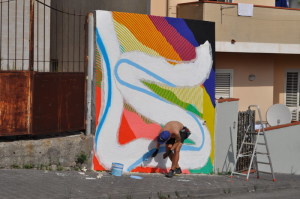
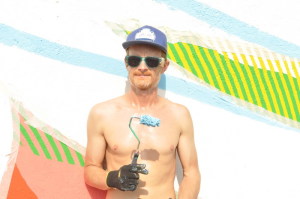
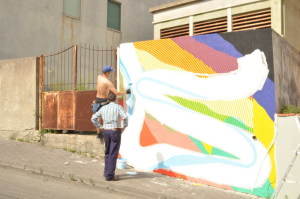
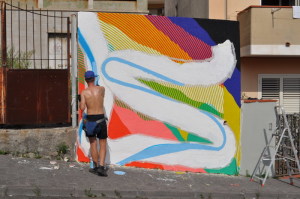
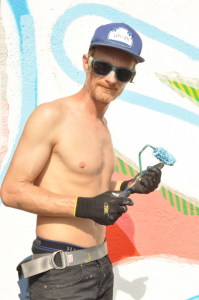
BIOGRAPHY: MOMO is an artist working in public spaces with homemade tools. His current interests lie with an evolving range of adapted masonry techniques to draft, design, and organize wall murals. Born in San Francisco in 1974, MOMO has travelled most of his life, lived in New York for six years and currently keeps a studio in New Orleans.
In 2008 Rojo published his first monograph “3AM – 6AM”; in 2012 Studio Cromie published his second, “In 74 Pieces”. In 2013 May Gallery hosted his first immersive installation show “Butt Joints” in New Orleans; Studio Cromie produced a Caribbean painting tour and exhibition in Southern Italy; and the New York DOT commissioned a 200-foot-long mural between the Brooklyn and Manhattan Bridges in Dumbo, Brooklyn. In 2015 MOMO created a 250 ft wide lobby mural for the John Hancock Tower in Boston, a 250 foot tall mural in downtown Philadelphia, and a double-facade 5 story printed vinyl mural in Manhattan, produced by Art Production Fund NY. In 2016 he and friends Maya Hayuk, Swoon, and Faile inaugurated the new Millennium Iconoclast Museum of Art in Brussels, with installations on five floors.
- Where does your inspiration come from?
- It comes from curiosity, often from everything. I am interested in natural light but everything is abstract, more abstract than abstract. Like this painting, which is not a curved bottle. In this painting I’m trying to make some colors to deliver some force, like exploring the unknown: you don’t know how it is going to develop, sometimes the wall wins and I am very proud of this ugly ugly pink. This painting hasn’t got a name, I usually never make a name for my paintings, sometimes the name of the street or whatever.
- Which technique do you use most?
- Many techniques, now I’m using tape, I move the tape and I can move the line usually. Also I listen to what people around me suggests. From a sketch I’m changing as we go, impressions to photograph again and again and develop on top of that, until it is a good composition like a song. I’m interested in that, we are playing with tapes and the 3-D effect is not my intention. The gesture of paintline is something contradictive with other gestures. In fact, with other elements we have other gestures. It is very important the research on the colors, it’s a mixture happening during the creation between “intention” and “improvisation”, like a musician does between “harmony” and “improvisation”.
This wall is good enough because it is not very rough: the tape stitches and the colors stitch well. If the wall is too much rough the colors don’t stitch well.
- Today-an-age we talk about urban actions as regeneration. In today’s street art what remains of its original “radicalism”?
- I think you are describing something for a big journalism article. My radicalism was only to discover things and work in new areas, just painting. The tools of the system are taking advantage of this opportunity but in my case I’m just interested in painting. I said “no” to twenty festivals every year, every year I work with very few festivals. It’s not my goal to be involved in this business. I spend most of my time in my kinds of projects independently.
- What do you think about this place, Naxos, as a site for a urban art action?
- I don’t think it is street art, it is just a mural. In fact, I don’t use this name for eight years or something. Anyway, Naxos is a beautiful city and they are giving the maximum hospitality, they are really amazing. My next step will be elsewhere in Sicily which I love.
- Can you tell us the name of your assistants?
- Of course, they are Angelo Milano, Dan Bortz and Lynnea Holland-Weiss.
- And your real name?
- No, it’s a secret.

